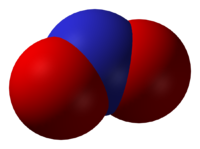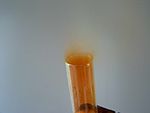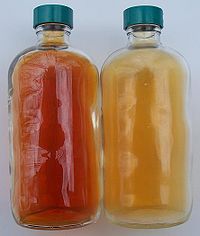Nitrogen dioxide
| Nitrogen dioxide | |
|---|---|
 |
 |
 |
|
|
Preferred IUPAC name
Nitrogen dioxide
|
|
|
Nitro
|
|
| Identifiers | |
| CAS number | 10102-44-0 |
| PubChem | 3032552 |
| ChemSpider | 2297499 |
| EC number | 233-272-6 |
| UN number | UN 1067 |
| ChEBI | 33101 |
| RTECS number | QW9800000 |
| Gmelin Reference | 976 |
|
SMILES
O=[N]=O
|
|
|
InChI
InChI=1S/NO2/c2-1-3
Key: JCXJVPUVTGWSNB-UHFFFAOYSA-N |
|
| Properties | |
| Molecular formula | NO2 |
| Molar mass | 46.0055(5) g/mol |
| Appearance | brown gas |
| Density | 1449 kg/m3 (liquid, 20 °C) 3.4 kg/m3 (gas, 22 °C) |
| Melting point |
-11.2 °C, 262 K, 12 °F |
| Boiling point |
21.1 °C, 294 K, 70 °F |
| Solubility in water | reacts |
| Refractive index (nD) | 1.449 (20 °C) |
| Structure | |
| Molecular shape | bent, C2v |
| Hazards | |
| MSDS | ICSC 0930 |
| EU Index | 007-002-00-0 |
| EU classification | Highly toxic (T+) Corrosive (C) |
| R-phrases | R26, R34 |
| S-phrases | (S1/2), S9, S26, S28,S36/37/39, S45 |
| NFPA 704 |
 0
3
0
OX
|
| Flash point | Non-flammable |
| Related compounds | |
| Related Nitrogen oxides | Ozone Nitrous oxide Nitric oxide Dinitrogen trioxide Dinitrogen tetroxide Dinitrogen pentoxide |
| Except where noted otherwise, data are given for materials in their standard state (at 25 °C, 100 kPa) |
|
| Infobox references | |
Nitrogen dioxide is the chemical compound with the formula NO2. One of several nitrogen oxides, NO2 is an intermediate in the industrial synthesis of nitric acid, millions of tons of which are produced each year. This reddish-brown toxic gas has a characteristic sharp, biting odor and is a prominent air pollutant. Nitrogen dioxide is a paramagnetic bent molecule with C2v point group symmetry.
Contents |
Occurrence
NO2 exists in equilibrium with dinitrogen tetroxide (N2O4):
- 2 NO2
 N2O4
N2O4
The equilibrium is characterized by ΔH = −57.23 kJ/mol, which is exothermic. Resulting from an endergonic reaction at higher temperatures, the paramagnetic monomer is favored. Colourless diamagnetic N2O4 can be obtained as a solid melting at m.p. −11.2 °C.[1]
Preparation and reactions
Nitrogen dioxide typically arises via the oxidation of nitric oxide by oxygen in air:[1]
- 2 NO + O2 → 2 NO2
In the laboratory, NO2 can be prepared in a two step procedure by thermal decomposition of dinitrogen pentoxide, which is obtained by dehydration of nitric acid:
- 2 HNO3 → N2O5 + H2O
- 2 N2O5 → 4 NO2 + O2
The thermal decomposition of some metal nitrates also affords NO2:
- 2 Pb(NO3)2 → 2 PbO + 4 NO2 + O2
Main reactions
The chemistry of nitrogen dioxide has been investigated extensively. At 150 °C, NO2 decomposes with release of oxygen via an endothermic process (ΔH = 114 kJ/mol):
- 2 NO2 → 2 NO + O2
As suggested by the weakness of the N–O bond, NO2 is a good oxidizer and will sustain the combustion, sometimes explosively, with many compounds, such as hydrocarbons.
It hydrolyzes with disproportionation to give nitric acid:
- 3 NO2 + H2O → NO + 2 HNO3
This reaction is one step in the Ostwald process for the industrial production of nitric acid from ammonia.[2] Nitric acid decomposes slowly to nitrogen dioxide, which confers the characteristic yellow color of most samples of this acid:
- 4 HNO3 → 4 NO2 + 2 H2O + O2
NO2 is used to generate anhydrous metal nitrates from the oxides:[1]
- MO + 3 NO2 → 2 M(NO3)2 + NO
Alkyl and metal iodides give the corresponding nitrites:
- 2 CH3I + 2 NO2 → 2 CH3NO2 + I2
- TiI4 + 4 NO2 → Ti(NO2)4 + 2 I2
The pure gas is produced by adding concentrated nitric acid over tin. Stanic acid is produced as biproduct.
4HNO3 + Sn → H2O + H2SnO3 + 4 NO2
Safety and pollution considerations
Nitrogen dioxide is toxic by inhalation, but this can be avoided as the material is acrid and easily detectable by smell. One potential source of exposure is fuming nitric acid, which spontaneously produces NO2 above 0 °C. Symptoms of poisoning (lung edema) tend to appear several hours after one has inhaled a low but potentially fatal dose. Also, low concentrations (4 ppm) will anesthetize the nose, thus creating a potential for overexposure.
Long-term exposure to NO2 at concentrations above 40– 100 µg/m3 causes adverse health effects.[3]
Nitrogen dioxide is formed in most combustion processes using air as the oxidant. At elevated temperatures nitrogen combines with oxygen to form nitric oxide:
- O2 + N2 → 2 NO
Nitric oxide can be oxidized in air to form nitrogen dioxide, although at normal atmospheric concentrations this is a very slow process.
- 2 NO + O2 → 2 NO2
The most important sources of NO2 are internal combustion engines,[4] thermal power stations and, to a lesser extent, pulp mills. Butane gas heaters and stoves are also sources. The excess air required for complete combustion of fuels in these processes introduces nitrogen into the combustion reactions at high temperatures and produces nitrogen oxides (NOx). Limiting NOx production demands the precise control of the amount of air used in combustion.

Nitrogen dioxide is also produced by atmospheric nuclear tests, and is responsible for the reddish colour of mushroom clouds.[5]
Nitrogen dioxide is a large scale pollutant, with rural background ground level concentrations in some areas around 30 µg/m3, not far below unhealthy levels. Nitrogen dioxide plays a role in atmospheric chemistry, including the formation of tropospheric ozone. A 2005 study by researchers at the University of California, San Diego, suggests a link between NO2 levels and Sudden Infant Death Syndrome.[6]
See also

- Dinitrogen tetroxide
- Nitryl
- Nitrous oxide (N2O), "laughing gas", a linear molecule, isoelectronic with CO2 but with a nonsymmetric arrangement of atoms (NNO)
- Nitric oxide (NO), a problematic pollutant that is short lived because it converts to NO2 in the presence of free oxygen.
External links
- International Chemical Safety Card 0930
- National Pollutant Inventory - Oxides of nitrogen fact sheet
- NIOSH Pocket Guide to Chemical Hazards
- WHO-Europe reports: Health Aspects of Air Pollution (2003) (PDF) and "Answer to follow-up questions from CAFE (2004) (PDF)
- Nitrogen Dioxide Air Pollution
- Nitrogen dioxide pollution in the world (image)
References
- ↑ 1.0 1.1 1.2 Holleman, A. F.; Wiberg, E. "Inorganic Chemistry" Academic Press: San Diego, 2001. ISBN 0-12-352651-5.
- ↑ Michael Thiemann, Erich Scheibler, Karl Wilhelm Wiegand “Nitric Acid, Nitrous Acid, and Nitrogen Oxides” in Ullmann’s Encyclopedia of Industrial Chemistry, Wiley-VCH, 2005, Weinheim.
- ↑ "Health Aspects of Air Pollution with Particulate Matter,Ozone and Nitrogen Dioxide". http://www.euro.who.int/document/e79097.pdf. Retrieved 2008-02-25.
- ↑ Son, Busoon; Wonho Yang, Patrick Breysse, Taewoong Chung and Youngshin Lee (March 2004). "Estimation of occupational and nonoccupational nitrogen dioxide exposure for Korean taxi drivers using a microenvironmental model". Environmental Research 94 (3): 291–296. doi:10.1016/j.envres.2003.08.004. PMID 15016597. http://www.sciencedirect.com/science?_ob=ArticleURL&_udi=B6WDS-49WMV2W-1&_user=432163&_rdoc=1&_fmt=&_orig=search&_sort=d&view=c&_acct=C000020718&_version=1&_urlVersion=0&_userid=432163&md5=1568528cb723b88921f97d88ebddd336. Retrieved 2008-02-25.
- ↑ "Air emissions". Botnia. http://www.metsabotnia.com/en/default.asp?path=204,215,268,267. Retrieved 2008-02-25.
- ↑ "Sids Linked to Nitrogen Dioxide Pollution". http://www.medicineonline.com/news/12/1110/Sids-Linked-to-Nitrogen-Dioxide-Pollution.html. Retrieved 2008-02-25.